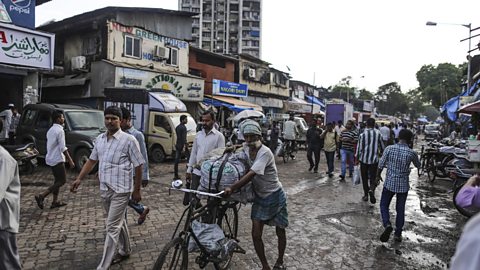Squatter settlements in Mumbai, India
Mumbai is an important port city on the northwest coast of India and is the state capital of Maharashtra. It operates as the commercial capital of India, it is important for manufacturing and finance and it is also the home of 'Bollywood' films.
Almost 21 million people lived in Mumbai in 2022, compared to less than 16 million in 2002. It is one of the most densely populated megacityA city with over 10 million people living in it. in the world, particularly the Island City sector with a population density of 43,000 people per square kilometre.
Mumbai has had a high level of natural increaseThe natural growth of a population due to the number of births exceeding deaths., as well as enormous rural to urban migrationThe movement of people from the countryside to the city. . A consequence of such rapid urbanisation is the development of squatter settlementAn area of makeshift housing, often unplanned and built illegally..
In Mumbai the squatter settlement of Dharavi is now home to over 1 million people. Many are second-generation families. Dharavi lies between two railway lines on low-lying land, previously used as a rubbish tip, and is one of the biggest squatter settlements in the world. The squatter settlement is unplanned and has these characteristics:
- it is overcrowded and noisy
- many houses are made from wood, corrugated iron, plastic sheeting or metal from oil drums
- houses become more substantial and permanent towards Dharavi's centre
- a lack of sanitation and clean drinking water for many residents
- pollution and disease are common from the open sewers - there are an average of 4,000 cases of typhoid and diphtheria each day
- thousands of workshops and people are employed in the informal job sectorCash-in-hand jobs where people do not pay taxes to the government. - 75% of people have a job and most work locally, with an annual turnover of £350 million. There are an estimated 15,000 single-room factories and around 5000 businesses
- a strong sense of community spirit and pride

Future plans for Dharavi
Squatter settlements can be improved through urban planning.
In 2004, a plan to improve Dharavi was put forward. Vision Mumbai aimed to replace squatter settlement housing with high-quality high-rise tower blocks of flats. In total, only 350 residents moved to new houses.
Many residents favour local, smaller-scale improvements. Local communities would remain intact and planning would involve ideas from the residents. This approach has lower costs than Vision Mumbai and is more sustainable.
Dharavi could copy the improvement approach, this approach worked in Rocinha, in Rio de Janeiro, Brazil, where the residents themselves improved the squatter settlements or 'favelas'. This is called a self-help schemeA type of informal programme that enables people to help themselves and their neighbours to improve their homes in developing countries..